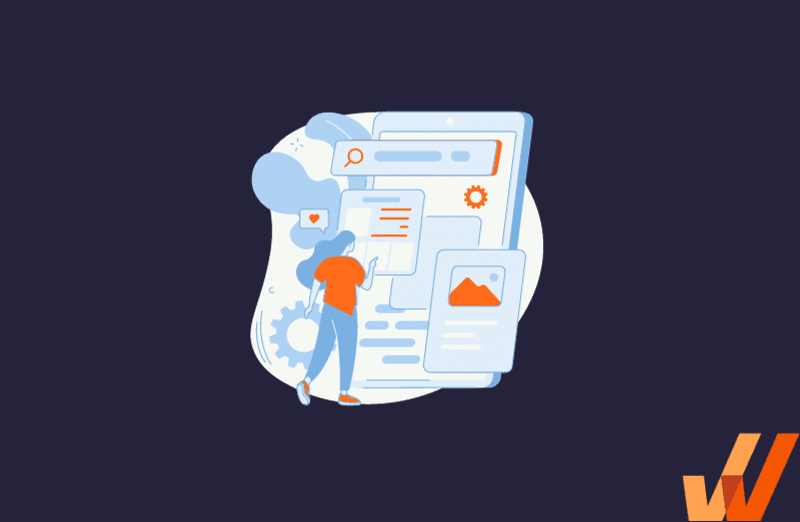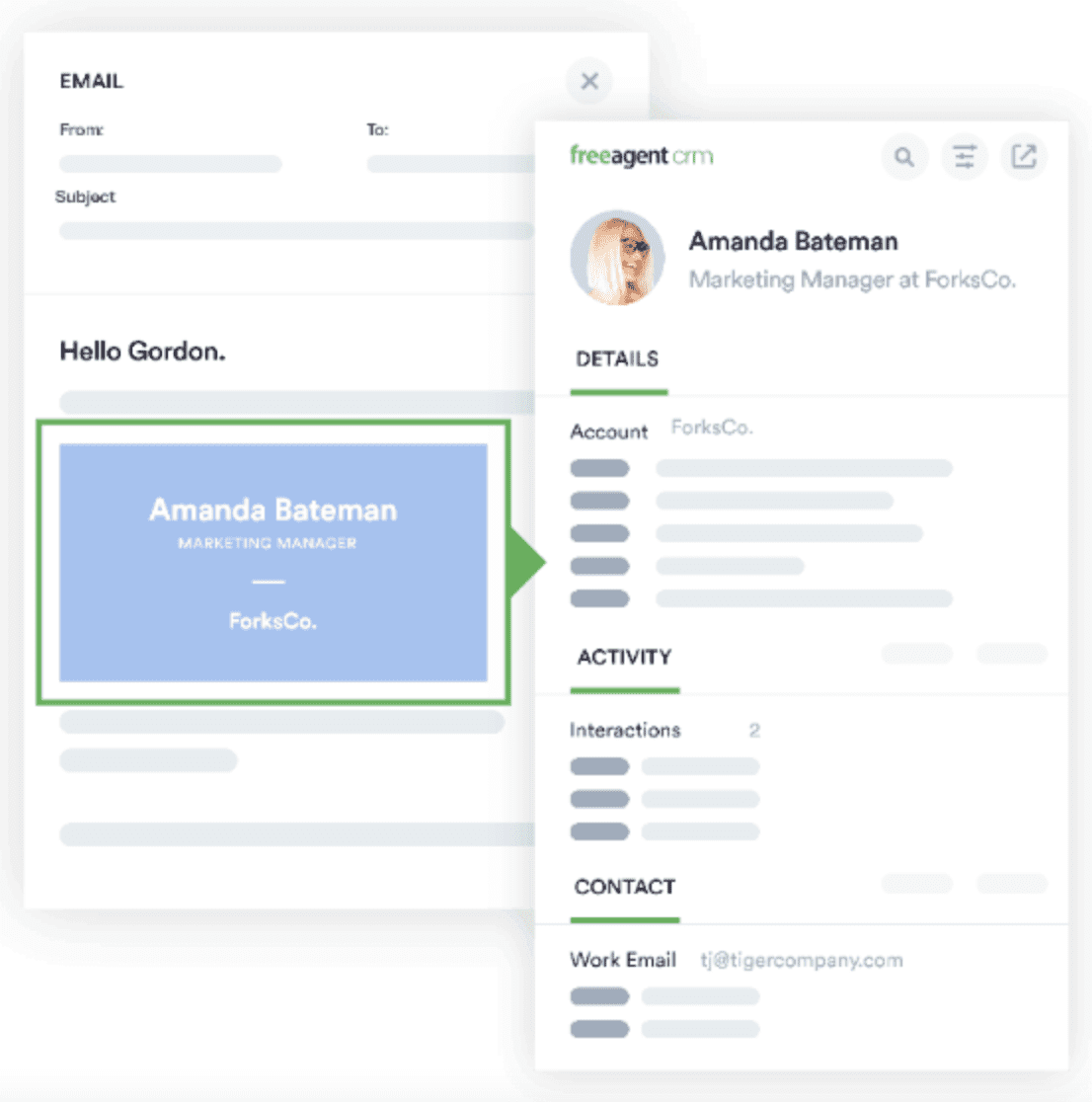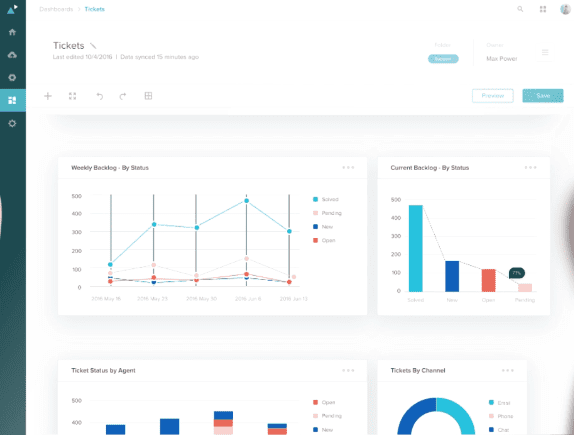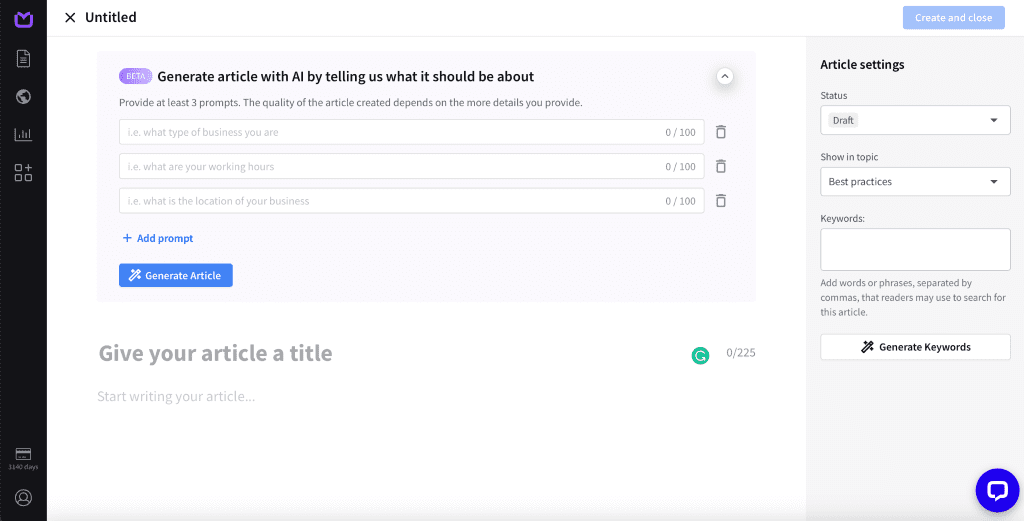
Andrew Dennis


Microsoft Dynamics’ State of Global Customer Service report found that 95% of consumers consider customer service as critical for brand loyalty, while 60% have switched to a rival company because of poor service. CX expert Esteban Kolsky found that 13% of your customers will tell 15 or more people if they have a negative experience, while 72% will tell six or more when they have a positive experience.
This means a deliberate approach towards your help desk is one (and possibly the most effective) way of cultivating brand loyalty and customer retention, driving positive word-of-mouth, and acquiring customers organically.
In this article, we’ll explore the concept of a help desk, its core benefits for product and service support, break down the core components of a practical help desk, and lay out critical best practices that help technical support teams overcome help desk-related challenges.
A help desk refers jointly to a team or department within an organization that provides real-time (usually technical) assistance to customers and software end-users, as well as the help desk systems and technology platforms that make it possible, including self-service, ticketing, and messaging tools. It’s often the first point of contact between your business and your customers, especially when they’re facing issues with your product/service offerings.
It’s not unusual for CX professionals to use ‘help desk’ and ‘service desk’ interchangeably—if for nothing else, they sound nearly identical (service teams are help teams, right?) and it seems the difference is only semantic. That’s not quite the case. Let’s look at the differences between help desk and a service desk.
The responsibilities of a service desk or help desk are similar, but nuanced differences make each a different tool for support teams.
The main difference is that a help desk focuses on helping customers in a more reactive and transactional manner. In contrast, a service desk allows companies to operate and scale IT service delivery that exceeds customer expectations through proactive, process-orientation approaches.
Depending on your product or service, both provide value for your end-users and the IT support team. Let’s further break down the main differences between a help desk and a service desk:
The type of help desk you need depends on your organization’s size, customer base (number and technical proficiency), international footprint (You’ll need agents across time zones to assist 24/7 if you have intl. users), and the relative size of the customers you work with (B2C vs. B2B vs. Enterprise), etc.
Mind you, in many of these examples, the differences are purely subjective:
For instance, what happens when an agent can’t resolve a customer’s issue and they’re at their wits end? Who do they escalate to and how? Or, what’s your operating procedure for restoring access to a customer that loses access to their email and ID?
A library of help desk-related SOPs and guidelines will help you offer a consistent support experience, limit surprises, and give your agents reusable advice for dealing with changing situations.
According to Zendesk’s 2020 CX Trends report, nearly three out of five buyers report that good customer service is essential for them to feel loyalty towards a brand, while a report by Bain and Company shows that a 5% increase in customer retention can increase profits by anywhere from 25% to 95%.
If we put both metrics together, we can easily infer that a great (or, even above average) help desk helps businesses cultivate brand loyalty, which in turn leads to higher revenues, customer retention, reduced customer churn, and increased profits.
A help desk serves as one source of truth for everything customer support-related: from handling customer conversations across channels (SMS, social platforms, live chat, email, etc.), to managing tickets, to tracking customer satisfaction, a help desk makes support less chaotic and makes it easy to roll out world-class support to your customers.

With all your customer conversations, issues, and feature requests in one place, it’s easier to manage support tickets, reassign conversations, and maintain one record that shows if, when and how issues are resolved.

A help desk gives you maximum visibility into your support operations, helps you resolve issues faster, and track customer satisfaction scores in real-time to understand what’s working and what to change about your approach to customer satisfaction.
As companies scale, their support pipeline tends to grow exponentially and easily becomes a cost center that needs more human agents, workflows, and tactics to manage. A well-designed help desk scales up with your organizations so that you can train more staff and create reusable self-help resources, guides, and product documentation to deflect tickets without any lapses in support quality.
Help desk platforms usually have a shared inbox feature where agents can reassign tickets to subject matter experts, view support requests from multiple channels in one place, and integrate with third-party tools so they can trigger processes without leaving their help desk application.
Help desk platforms are designed to track support metrics like first response times (FRT), customer satisfaction score (CSAT), customer effort score, Net Promoter Score, and average handle time (AHT) that offer real-time insights into the quality of support your CX team is offering customers, plus any opportunities for improvement.

There are several ways help desks (teams and software) can reduce response rates and time-to-resolution. For one, since they surface all customer issues into one inbox, it’s impossible for customers to fall through the cracks.
Secondly, customers can be directed to self-help resources (product docs, help articles, etc.) to resolve their issues almost immediately via if-then chatbots, instead of waiting in a queue for 1:1 human assistance.
On one hand, help desk platforms have easy-to-use content management solutions for authoring, editing, formatting, and sharing self-help content, including rich text articles, pre-recorded demos, GIFs, and videos, while help desk teams can create these to reduce their workload and deflect tickets effectively vs. answering every customer 1:1.

A help desk (i.e., both the software and human team behind it) isn’t an infallible panacea for customer challenges and you might struggle with handling increasing ticket volumes, integrating your help desk platform with third-party software, or catering to the needs of a diverse audience.
You might notice a spike in support tickets after launching a new product (or feature), if you make significant changes to your product or service offerings, if you encounter significant technical issues that impact customer experience. In such situations, it can be demanding if not impossible to ramp up your team and its self-help resources to handle such short-term spikes and manage support tickets at an effective pace when this occurs.
Most mainstream help desk software applications have simple, easy-to-setup integrations with popular SaaS tools. But, they can prove difficult to navigate if you’re trying to connect them with your on-premise software or custom help desk software.
This is more of a challenge if you use an in-house solution or an on-premise instance of a help desk platform. You might be behind on new versions, security patches, bug fixes, and upgrades that are critical to the help desk experience.
On one hand, while customer support aims to exceed customers’ expectations, you also need to balance their expectations with your resources and diplomatically communicate how long until they can hear back (or get their issues resolved).
Your help desk team and the software tools they use will be a hotbed of customer Personally Identifiable Information that can be a security risk if it falls into the hands of hackers and other bad actors. As a result, as you roll out your help desk, you also have to make corresponding investments in cybersecurity to protect your customers data and stay compliant with relevant regulations.
When you’ve finally chosen a help desk stack and built your support team, how do you ensure you’re giving your customers (or employees, if you’re building an internal help desk) the best support experience possible? Here are a couple of tips that can help you.
Support tickets are the first step users/customers will encounter when trying to report issues or making inquiries about your product or services. Evidently, you need to implement a help desk system that helps to:
Like we mentioned under the ‘multi-level help desk’ point, a grading system helps you classify tickets by issue, severity, customer LTV (pricing tier) to ensure your help desk team is always working on the most pressing issues per time.
Of course, this doesn’t mean you should snub low-ticket customers—you can simply use ticket priority level guidelines like above as a mental model or algorithm for prioritizing issues.
As of July 2024, 65.67% of the world’s 5.19 billion Internet users connect via mobile devices; Facebook alone has over 3 billion monthly active users; and 4.37 billion people across the globe use email—and there’s a good chance your customers fall into some or all of those buckets (mobile-first, social media, and email users).
That’s the biggest argument for multi-channel support: it gives you wider coverage to support users on the channels and platforms they already use and helps deflect support tickets with self-serviceability.
Don’t ship any product updates without updating your product documentation and knowledge base with relevant information; if possible, put up a suggestion widget on your help articles so that users can suggest edits or additions.

Your help desk agents’ level of skill will always be a bottleneck for the rest of your support system, no matter the quality of infrastructure you invest in. So, it’s important to set up a consistent customer service training regimen via 1:1 sessions, webinars, courses, and cohort-based programs to train your help desk agents to de-escalate issues, pinpoint fixes faster, and show empathy.
What should a help desk agent do after they’ve tried every fix in the books and an issue still isn’t resolved? Or if an agent gets a ticket with an unprecedented issue they haven’t encountered or documented yet. Set up clear escalation procedures for involving higher-ups and working out custom fixes when necessary.
Help desk platforms can be grouped into a couple of buckets, mainly based on their specific functionality and scope, including ticketing, knowledge base platforms, issues tracking, etc.
Like their name implies, live chat platforms facilitate real-time conversations between customers and help desk teams usually via multiple channels, such as (in-app or web-based) chatbots, email, SMS, social media platforms, etc.
Live chat solutions support a wide range of integrations so that help desk teams can route all their customer conversations into a shared inbox where they can reassign threads internally and track their ticket pipeline.
Knowledge base software like Confluence, Notion, Tettra, and Guru serve as a CMS where you can draft and publish help articles, documents, FAQs, how-to guides, and videos, typically grouped by category or topics for easy retrieval.
Essentially, they serve as a searchable self-support knowledge base where customers can find relevant resources using keywords or queries. Depending on the particular product you choose, they might also offer collaboration features (@mentions, collaborative editing), integrations with the rest of your stack (e.g., CRMs, etc.) role-based access, version control, multilingual support, and customized branding.
Remote support tools like AnyDesk, TeamViewer, LogMeIn, and RemotePC enable technical support teams to access and control a computer remotely. That way, IT support specialists can view and replicate issues from the user’s perspective (using real-time screen sharing), troubleshoot easily, transfer files, and record sessions for retroactive analysis.
Help desk analytics tools (e.g., HappyFox BI and Zoho analytics) help you filter through the data your help desk tools generate and provide insights into the performance and operations of your support team. They collect data from multiple touchpoints (support tickets, customer interactions, agent conversations, responses, etc.) plot trends in performance, identify frequent issues, and can also help you compare your metrics against industry-wide averages.
Customer self-service software platforms give your customers the tools to resolve their issues without contacting help desk agents—that way, you can reduce your time-to-resolution and deflect tickets before they’re even created.
The best way to explain how self-service platforms work would be to use an example, our product Whatfix, precisely: Whatfix helps you insert contextual help cues and guides across your product’s UI, including:
Self-service platforms reduce the degree of complexity required to educate users and make the support experience a customer-first, engaging adventure.

Above: Example of contextual help and user support built with a Digital Adoption Platform.
Whatfix’s Self-Help overlays on to any web application, desktop application, mobile app, or website. It provides contextual help to users and integrates with your FAQs, support center, LMS, user documentation, and more. Users are presented with common issues and help content for their contextual area in the application, or they can use an open-ended search to find the specific help content they’re looking for. These help support cards often prompt in-app guidance, walking users through the specific workflow they need help on.
Whatfix’s self-help support solution works as an add-on that completes your help desk infrastructure: whether you’re using Zendesk, Intercom, AnyDesk, etc., Whatfix can enable your users to find helpful content faster, get contextual assistance while using your product, and get insights into how users are interacting with your resource library.
With Whatfix, enable your customers and end-users with in-app guided experiences like product tours, interactive flows, tooltips, pop-ups, field validations, and more.
With Self-Help, provide end-users with an in-app help center that automatically crawls and aggregates your knowledge and documentation to bring answers to common support issues into your UI.
Whatfix’s Enterprise Insights and User Actions enable support teams to identify areas of user friction, common support issues that can direct new help content to create, map user flows, and track custom events.

Thank you for subscribing!